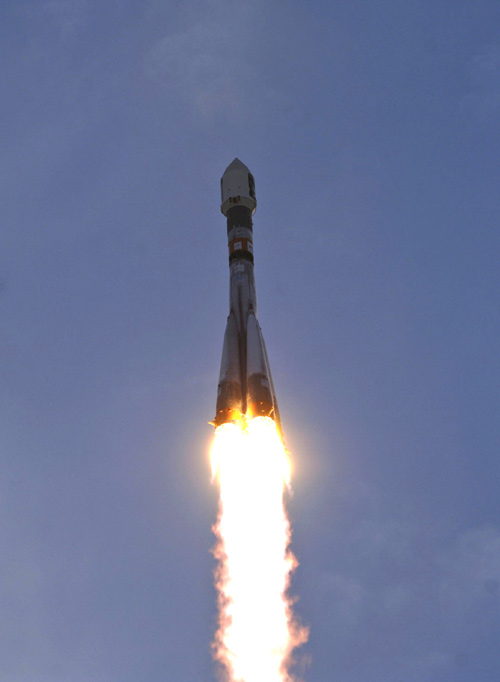Next Stop Venus: Europe's Express Probe Launches Toward Earth's 'Twin'

A Europeanprobe is bound for the planet Venus on a mission to peel back the shroud of theplanet's thick atmosphere after successfully launching into space atop a Russian rocket.
The EuropeanSpace Agency's (ESA) VenusExpress spacecraft rode a Russian-built Soyuz rocket into space at about10:33 p.m. Nov. 8 EST (0333 Nov. 9 GMT), lifting off from Baikonur Cosmodrome inKazakhstan on a 162-day trip to the second planet from the Sun.
By 12:13a.m. EST Wednesday, ESA officials said Venus Express had successfully fired theengine of its Fregat upper stage for a final time, sending the probe on aVenus-bound course. The probe later unfurled its solar arrays, ESA officialssaid.
"I havegreat expectations for this mission," Venus Express project scientist H?kan Svedhem told SPACE.comin an e-mail interview before launch. "I am sure we will get very exciting dataand perhaps a few surprises."
The $260million (220 million Euro) Venus Express probe is the ESA's fastest spacecraftto develop to date, taking less than four years to move from the concept phaseto launch, and its first aimed at Venus. While several probes have swung past theplanet on their way to other bodies in the Solar System, the ESA's VenusExpress is the first dedicated probe to investigate the cloudy world since NASA'sMagellan orbiterburned up in the planet's atmosphere in 1994.
"The atmosphereof Venus is so alien compared to Earth, yet it's our sister planet," KevinBaines, a scientist from NASA's Jet Propulsion Laboratory (JPL) participatingin the ESA mission, told SPACE.com before launch. "We've got the samesize, the same materials basically and almost the same gravity."
Butsomewhere along the line, Earth's neighbor clouded over with a thick atmosphererich in carbon dioxide, and a surface temperature of averaging about 869degrees Fahrenheit (465 degree Celsius). Researchers believe the planet may beexample of the greenhouse effect run amok, in which the world's atmospheretraps in heat.
Get the Space.com Newsletter
Breaking space news, the latest updates on rocket launches, skywatching events and more!
"Venus hasa lot of lessons to teach the Earth about how things could go awry," said Baines,who is participating on work with two Venus Express' instruments.
The 2,733-pound(1240-kilogram) probe carries seven high fidelity instruments - many of whichleftover or derived from previous tools aboard ESA's MarsExpress and Rosettaprobes - to make a detailed study of the planet's atmosphere.
While Venus Express' primary goal is to peer close at the Venusianatmosphere, Svedhem and other mission team members are hopeful the spacecraft'sinstruments may find hints of active volcanoes and other features on theplanet's surface.
"We shallget detailed images of the dynamic behavior of the atmosphere in threedimensions and spectra telling us the about the various substances in theatmosphere," Svedhem said. "There are so many things that we want to study onVenus and the spacecraft and the instruments are all in excellent condition."
Tuesday'slate-night launch - though it was early morning on Nov. 9 at the mission'sKazakh launch site - marked the second attempt to launch Venus Express.
Launchofficials missedan initial Oct. 26 launch date after engineers discovered traces of insulationcontamination inside the probe's protective launch fairing. The contaminationforced pad workers to remove Venus Express from its Soyuz-Fregat booster toallow cleaning.
"This Soyuzrocket has proven to be very reliable and it has a very good record," Svedhemadded.
ESAofficials expect Venus Express to enter orbit around its target planet on April11 of next year. After a series of passes to adjust its orbit, the probe shouldreach its final flight configuration by about May 7, they added.
VenusExpress is slated to spend at least 15 months studying the Venusian atmosphere -which spans about two full days on Venus due to its slow spin rate - though thatterm could be extended in the future, ESA officials said.
- A Cloudy Target: Europe's Venus Express Probe to Explore Shrouded Planet
- Venus and Earth: Worlds Apart
- Image Gallery: Beneath the Clouds of Venus
Join our Space Forums to keep talking space on the latest missions, night sky and more! And if you have a news tip, correction or comment, let us know at: community@space.com.

Tariq is the Editor-in-Chief of Space.com and joined the team in 2001, first as an intern and staff writer, and later as an editor. He covers human spaceflight, exploration and space science, as well as skywatching and entertainment. He became Space.com's Managing Editor in 2009 and Editor-in-Chief in 2019. Before joining Space.com, Tariq was a staff reporter for The Los Angeles Times covering education and city beats in La Habra, Fullerton and Huntington Beach. In October 2022, Tariq received the Harry Kolcum Award for excellence in space reporting from the National Space Club Florida Committee. He is also an Eagle Scout (yes, he has the Space Exploration merit badge) and went to Space Camp four times as a kid and a fifth time as an adult. He has journalism degrees from the University of Southern California and New York University. You can find Tariq at Space.com and as the co-host to the This Week In Space podcast with space historian Rod Pyle on the TWiT network. To see his latest project, you can follow Tariq on Twitter @tariqjmalik.
